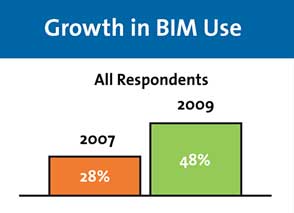Building Information Modeling (BIM) and Manufactured Complementary Building Products
The integration of both graphic and non-graphic information in one place gives the Model much more value as a resource that can be accessed by many people instead of wasting time and money to duplicate. The current wastefulness and redundancy in building design and construction work, while difficult to accurately quantify, is estimated by NIBS at a figure approaching $400 billion dollars annually, without taking operating processes into account. Eliminating this waste has been a key motivator on the part of owners and others who seek a superior building outcome by incorporating a more coordinated non-redundant methodology.
NIBS has also launched a specific initiative known as the buildingSMARTallianceâ„¢, which has compared the rise in the use of electronic modeling for buildings to similar changes that have preceded it in the aircraft, microprocessor and automotive industries. Based on those other industry successes, BIM is usually characterized as having several key features:
• Digital or electronic format. The Model is created entirely on computers.
• Parametric object-based. The information in the Model is not a series of lines and shapes as in many Computer Aided Design (CAD) applications, rather it is a collection of three-dimensional "objects" that are inserted or virtually "built" into the Model. The objects are often selected or created generically in BIM software programs or custom created by design professionals. Parametric objects are those that automatically adjust to other objects in a model, such that if a change is made to the model that affects the size or location or spacing of the object, it moves and adjusts accordingly.
• Embedded information linkage. Beyond the physical representation of an object, the functional data (e.g. specifications, warranty, manufacturing information, etc.) associated with that object is embedded or linked to the BIM object and readily accessible and readable.
• Interoperable. With information coming from multiple sources, the ability to openly and easily share that information in generic formats without the restrictions of proprietary software becomes critical. This point is common among a number of computer-based activities and has strong precedent elsewhere. In fact, the Institute of Electrical and Electronics Engineers (I-triple E) has spent a considerable amount of effort looking at this topic and offers this definition of interoperability: "The ability of two or more systems or components to exchange information and to use the information that has been exchanged."
A Model that incorporates all of these features lives up to the true definition of BIM and its ability to deliver desired results.
THE GROWING USE OF BIM
 |
|
Source: McGraw Hill Construction 2009 Smart Market Report - The Business Value of BIM |
Of course, any tool is only of value if it is actually used and put into practice. In order to understand the current and projected usage trends and perceived value of BIM in practice, McGraw- Hill Construction has undertaken a series of objective studies in partnership with NIBS, the American Institute of Architects (AIA), and others and published the findings as a "Smart Market Report - The Business Value of BIM" (see  www.aia.org/ipd). The 2009 printing of this report updates the findings of the prior 2007 edition and reveals some insights into who is using BIM and why. This study is based on input from information gathering surveys from literally thousands of participants that came from all parts of the Architecture, Engineering and Construction (AEC) spectrum across North America. Some of the highlights of this study are summarized below:
• Almost half (49%) of the total AEC industry is now using BIM. This usage level is up considerably since 2007 when the same study revealed that only 28% of the total industry was using BIM or BIM related tools at that time. This represents some dramatic recent growth - a 75% increase in two years. Further, proficiency is up dramatically too with three times as many users characterizing themselves as advanced or experts - 42% in 2009 compared to only 14% in 2007.
 |
Source: McGraw Hill Construction 2009 Smart Market Report - The Business Value of BIM |









